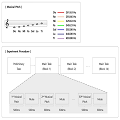Abstract
Neural coding of auditory stimulus frequency is well-documented; however, the cortical signals and perceptual correlates of pitch have not yet been comprehensively investigated. This study examined the temporal patterns of event-related potentials (ERP) in response to single tones of pitch chroma, with an assumption that these patterns would be more prominent in musically-trained individuals than in non-musically-trained individuals. Participants with and without musical training (N=20) were presented with seven notes on the C major scale (C4, D4, E4, F4, G4, A4, and B4), and whole-brain activities were recorded. A linear regression analysis between the ERP amplitude and the seven notes showed that the ERP amplitude increased or decreased as the frequency of the pitch increased. Remarkably, these linear correlations were anti-symmetric between the hemispheres. Specifically, we found that ERP amplitudes of the left and right frontotemporal areas decreased and increased, respectively, as the pitch frequency increased. Although linear slopes were significant in both groups, the musically-trained group exhibited marginally steeper slope, and their ERP amplitudes were most discriminant for frequency of tone of pitch at earlier latency than in the non-musically-trained group (~460 ms vs~630 ms after stimulus onset). Thus, the ERP amplitudes in frontotemporal areas varied according to the pitch frequency, with the musically-trained participants demonstrating a wider range of amplitudes and inter-hemispheric anti-symmetric patterns. Our findings may provide new insights on cortical processing of musical pitch, revealing anti-symmetric processing of musical pitch between hemispheres, which appears to be more pronounced in musically-trained people.
